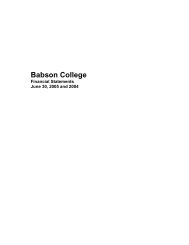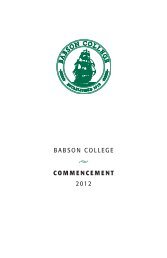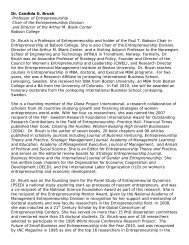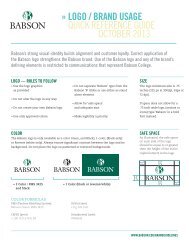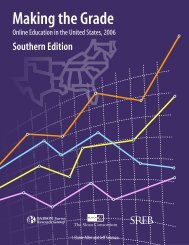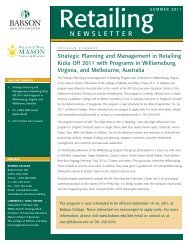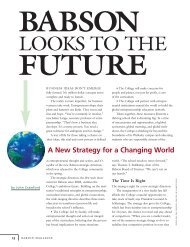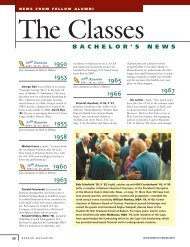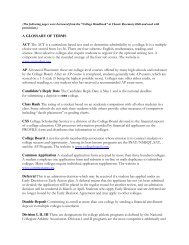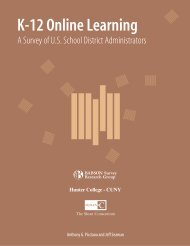Outstanding in Their Fields - Babson College
Outstanding in Their Fields - Babson College
Outstanding in Their Fields - Babson College
- No tags were found...
Create successful ePaper yourself
Turn your PDF publications into a flip-book with our unique Google optimized e-Paper software.
outstand<strong>in</strong>gThe word “entrepreneur” typically doesn’tconjure up images of pastures and pitchforks.But we talked with <strong>Babson</strong> alumni who makea liv<strong>in</strong>g on the land. Turns out,the entrepreneurial spirit drives tractors, too.By Donna CocoKen Nicewicz,MBA ’73, ofNicewiczFamily Farmtom kates12 <strong>Babson</strong> Magaz<strong>in</strong>e www.babson.edu/magaz<strong>in</strong>e
<strong>in</strong> their fieldstom katessummer 2011 13
dur<strong>in</strong>g the height of summer, whenthe hot, sticky days eat <strong>in</strong>to thenights, Ken Nicewicz, MBA ’73, rollsout of bed ahead of the sun. He andhis three brothers need to harvestears of sweet corn before hitt<strong>in</strong>g thelocal farmers markets. “We prideourselves on pick<strong>in</strong>g our corn freshevery day,” says Nicewicz. “I’ve alwayswanted to take a picture of us <strong>in</strong> the truck with today’snewspaper—you know, with the date on it, when it’s just gett<strong>in</strong>glight—and caption it, ‘This is when your corn was picked.’”Corn is just one of the offer<strong>in</strong>gs from the third-generationNicewicz Family Farm <strong>in</strong> Bolton, Mass., which Nicewicz’s grandparentsbought <strong>in</strong> 1929. The brothers grow herbs and vegetablesalong with blueberries. But most of the 30-plus farmed acres ofroll<strong>in</strong>g hills conta<strong>in</strong> row after row of fruit trees—apples, apricots,cherries, nectar<strong>in</strong>es, peaches, pears, and plums. Pick<strong>in</strong>g plums isone of Nicewicz’s favorite tasks. “You have this piece of fruit <strong>in</strong>your hand, and it’s dead ripe,” he says with a slight smile. “Andyou see this little peck from a bird, and you really can’t sell it. Soyou have to do someth<strong>in</strong>g with it. Some morn<strong>in</strong>gs I come downfrom the farm to the truck and say, ‘I th<strong>in</strong>k I’ve eaten 20 plums.’”Nicewicz’s occasional <strong>in</strong>dulgences aside, the majority of theproduce goes to farmers markets—11 markets, six days a week—for direct sales to customers. “It’s a lot of fun,” says Nicewicz ofthe out<strong>in</strong>gs. “We get to know our customer base quite nicely, andthey get to know us.” The family makes most of its money fromthese venues, although a newly renovated roadside stand br<strong>in</strong>gs<strong>in</strong> sales as does a pick-your-own side of the bus<strong>in</strong>ess.The farm didn’t always operate this way. In the ’60s and ’70s,when Nicewicz’s dad ran the farm, they planted only apple andpear trees and sold ma<strong>in</strong>ly to wholesalers. “When you sell wholesale,you sell at a reduced price,” says Nicewicz. Realiz<strong>in</strong>g that retailwould better benefit the farm’s bottom l<strong>in</strong>e, he adapted thefarm to its current more profitable model.He and his sibl<strong>in</strong>gs (the lone Nicewicz sister, who works for alocal school, pitches <strong>in</strong> on the farm whenever she f<strong>in</strong>ds the time)also sold the development rights to 70 of the farm’s 100 acres tothe state’s agriculture preservation program, guarantee<strong>in</strong>g thoseacres will rema<strong>in</strong> farmland. “We’ve put our blood, sweat, andtears <strong>in</strong>to this farm,” he says. “We didn’t want a future [owner] tosell it off for hous<strong>in</strong>g.”As the only one <strong>in</strong> his family who attended college and earnedan MBA, Nicewicz says his education helps with all the decisionsthat he and his brothers make. “There’s so much that I ga<strong>in</strong>edfrom my education that I can’t put it <strong>in</strong>to words,” he says. “It’sjust the whole sense of the bus<strong>in</strong>ess. Farm<strong>in</strong>g is a bus<strong>in</strong>ess.”Cattle callNative Australian Tony Coote ’60 knows about bus<strong>in</strong>ess. Formore than four decades, he worked for his family’s jewelry firm,Angus & Coote, half of that time serv<strong>in</strong>g as CEO and then chairman.When the bus<strong>in</strong>ess was sold <strong>in</strong> 2007, it <strong>in</strong>cluded 350 stores.But Coote always has been <strong>in</strong>trigued by farm<strong>in</strong>g. “I worked onour own farm,” he says of his youth, “and I spent a lot of time onother people’s farms.”The draw was so strong that <strong>in</strong> 1968 Coote bought a graz<strong>in</strong>granch that raised cattle and sheep <strong>in</strong> Bungendore near Canberra,New South Wales. He describes his purchase as “very small” and“economically unviable.” “It wasn’t terribly rational,” he sayswith a chuckle. “The only rational part was it’s centrally located.”Coote worked the farm part time for years, gradually expand<strong>in</strong>git and mak<strong>in</strong>g it more viable. About 10 years ago, he tradedhis bus<strong>in</strong>ess suit and loafers for jeans and boots full time. Todayphoto courtesy of mulloon creek natural farms14 <strong>Babson</strong> Magaz<strong>in</strong>e www.babson.edu/magaz<strong>in</strong>e
Tony Coote ’60of Mulloon CreekNatural FarmsMulloon Creek Natural Farms consists of nearly 6,000 acres, andeight families live on and work the land. They still raise cattle, directlysell<strong>in</strong>g the meat, and have added free-range chickens foregg sales. They also grow their own vegetables, butcher theirown meat, and milk their own cows, consum<strong>in</strong>g the raw milkand cream and mak<strong>in</strong>g cheese and butter.Until about 20 years ago, Coote followed conventional methodsof farm<strong>in</strong>g and graz<strong>in</strong>g, treat<strong>in</strong>g the land with pesticides andchemicals. “We dra<strong>in</strong>ed and m<strong>in</strong>ed the soil, and we still weren’teconomically viable,” he says. Then he switched to biodynamics,a holistic and regenerative organic farm<strong>in</strong>g system based onknowledge of the earth and the cosmos. Its unusual practices—plant<strong>in</strong>g by the lunar calendar, for example—might be consideredfr<strong>in</strong>ge by some, especially the unfamiliar.Coote, however, wasn’t swayed. “We had a severe drought <strong>in</strong>the early ’80s,” he says. “We saw another farmer about an houraway—a wild character—who did his farm<strong>in</strong>g us<strong>in</strong>g biodynamics.We went and had a look, and we saw the evidence of cloverabout three feet high above the ground and three feet rooted belowthe ground. And it was the dry season on top of a dry hill.From that po<strong>in</strong>t on, we started do<strong>in</strong>g biodynamics.”He contemplates that deep <strong>in</strong>side, he had an <strong>in</strong>tuitive understand<strong>in</strong>gthat this was the right decision for his farm. “Entrepreneursare motivated more by a feel<strong>in</strong>g than anyth<strong>in</strong>g rational,” hesays. “Even E<strong>in</strong>ste<strong>in</strong> <strong>in</strong>tuited his great discoveries.”The transition was tough at first, and some animals died.“The gene pool was weak,” he says, “but we never knew it becausewe propped them up prophylactically with chemicals. Andwe were eat<strong>in</strong>g those animals. But now we really do follow natureand learn lessons from nature, where the weak are supposed todie. You breed the strong ones.” Now the farm is 400 cattlestrong, not to mention the 12,000 chickens that roam the fields.Hydrat<strong>in</strong>g the land is another important concern of Coote’s.Dehydration from overgraz<strong>in</strong>g and excessive clear<strong>in</strong>g and cropp<strong>in</strong>gis a major problem <strong>in</strong> many parts of the world, he notes, <strong>in</strong>clud<strong>in</strong>gAustralia. In 2006, he began a project on a three-milestretch of the creek that uses Natural Sequence Farm<strong>in</strong>g, whichaims to rehabilitate rivers and streams through biological solu-summer 2011 15
photo courtesy of heidelberry farms“What he’s basically say<strong>in</strong>g,” expla<strong>in</strong>s Dave, “is ‘I get to be ona tractor and not <strong>in</strong> here.’ That’s the loose translation.” Al laughs,but doesn’t deny it. “That’s sort of the best part of the job,” cont<strong>in</strong>uesDave. “I can be here <strong>in</strong> the office for six hours, beat<strong>in</strong>g myhead aga<strong>in</strong>st the wall, and if I can get an hour outside, it sort ofevens you out a little bit.”Although sometimes frustrated by his job, Dave can’t imag<strong>in</strong>edo<strong>in</strong>g anyth<strong>in</strong>g else. “There’s always someth<strong>in</strong>g different go<strong>in</strong>gon. Work<strong>in</strong>g with nature, someth<strong>in</strong>g you can’t predict—you canprepare as much as you want, but generally you’re react<strong>in</strong>g almostthe entire time. And I like that.”Reluctant farmersA bus<strong>in</strong>ess need drove Hillary Hunter ’92 and Kay (pronounced“Ki”) Hilsberg ’93 to become farmers. In 1995 they foundedHunter & Hilsberg, a mail order and wholesale operation sell<strong>in</strong>gspecialty foods and accessories <strong>in</strong> the U.S. and Germany (Hilsberg’sbirthplace). When the couple started, plenty of vendorsprovided the type and quality of products the two sought. “We’df<strong>in</strong>d companies that could make our recipes and pack them withour brand<strong>in</strong>g, and that was it,” says Hunter.But then vendors of the jams, jellies, and other fruit-based offer<strong>in</strong>gsthey counted on started disappear<strong>in</strong>g. “We work with alot of small- to medium-sized bus<strong>in</strong>esses with their own life cycles,”says Hunter. “They’d go out of bus<strong>in</strong>ess, or they’d sell theirbus<strong>in</strong>ess, or there was a problem with what they were supply<strong>in</strong>g.It became a question of how do we get good product?”So their company, Hunter & Hilsberg, obta<strong>in</strong>ed a food productionlicense, allow<strong>in</strong>g them to produce fruit-related goodies to fill<strong>in</strong> the gaps. Not what Hunter wanted, but grow<strong>in</strong>g up she’d madepies, jellies, and preserves with her grandmother, so it wasn’tcompletely foreign. Then another roadblock arose. F<strong>in</strong>d<strong>in</strong>g fruitsfrom local farmers became <strong>in</strong>creas<strong>in</strong>gly difficult.Thus began their five-year quest for farmland <strong>in</strong> the F<strong>in</strong>gerLakes region of upstate New York, near their Syracuse home.“Our biggest obstacle was the depletion of available farmland dueto the spread of residential development tracts,” says Hunter.“Few American farmers have the resources to retire except to selloff their land for residential development. In the end, we had tobuy several [undeveloped] parcels at residential developmentprices and turn them back <strong>in</strong>to agricultural land.”The two now own 40 acres of mostly uncultivated farmland,which came as organic and will rema<strong>in</strong> organic, says Hunter.Some fruits the land already provided. Wild blackberries grow“wherever and however they please,” she says. Wild strawberriesand raspberries also abound, as do some apple trees.Kay Hilsberg ’93 (left) and Hillary Hunter ’92 of Heidelberry FarmsBut it’s the rarer fruits that pique Hunter’s <strong>in</strong>terest—currants,elderberries, and gooseberries. With just the two of them mann<strong>in</strong>gthe farm, they plant these treasures <strong>in</strong> small, <strong>in</strong>crementalsteps. “We say, ‘What’s the fruit we can’t f<strong>in</strong>d from somebody elseright now? How much can we afford to plant <strong>in</strong> terms of budgetand time?’ And then we plant,” says Hunter. Due to their efforts,cranberries also now <strong>in</strong>habit the land.Hav<strong>in</strong>g worked with fruit farms and v<strong>in</strong>eyards through theirfood bus<strong>in</strong>ess for years, the two felt more comfortable with theidea of farm<strong>in</strong>g than one might expect. And although Hunter recognizesthat farm<strong>in</strong>g is vastly different from garden<strong>in</strong>g, the latterhas been part of her life s<strong>in</strong>ce her youth as well. “We also did a lotof research and relied on the good graces of others <strong>in</strong> the agriculturalcommunity to provide tips and po<strong>in</strong>ters,” says Hunter.The farm (named Heidelberry Farms) has presented Hunterand Hilsberg with yet another challenge. Construction on theirhouse derailed when it became clear that hook<strong>in</strong>g up to the energygrid would be impractical and expensive compared to produc<strong>in</strong>gtheir own energy. Thus began their new quest: to create acompletely off-the-grid production farm us<strong>in</strong>g renewable energy,which turns out would be the first <strong>in</strong> the country. “I know whatwe’re do<strong>in</strong>g sounds crazy,” says Hunter. “Be<strong>in</strong>g off the grid cameas a surprise. And I never <strong>in</strong>tended for us to be producers orfarmers. I th<strong>in</strong>k the entrepreneur is someone who is go<strong>in</strong>g to dosometh<strong>in</strong>g regardless of the obstacles. They’re will<strong>in</strong>g to take arisk and have faith that they can do it and not be afraid of failure.“<strong>Babson</strong> gave us the skills needed not only to manage the unexpectedwhen it happens but welcome those challenges. Becausewe have acquired those skills, we can enjoy the process ofturn<strong>in</strong>g lemons <strong>in</strong>to lemonade.”summer 2011 17



